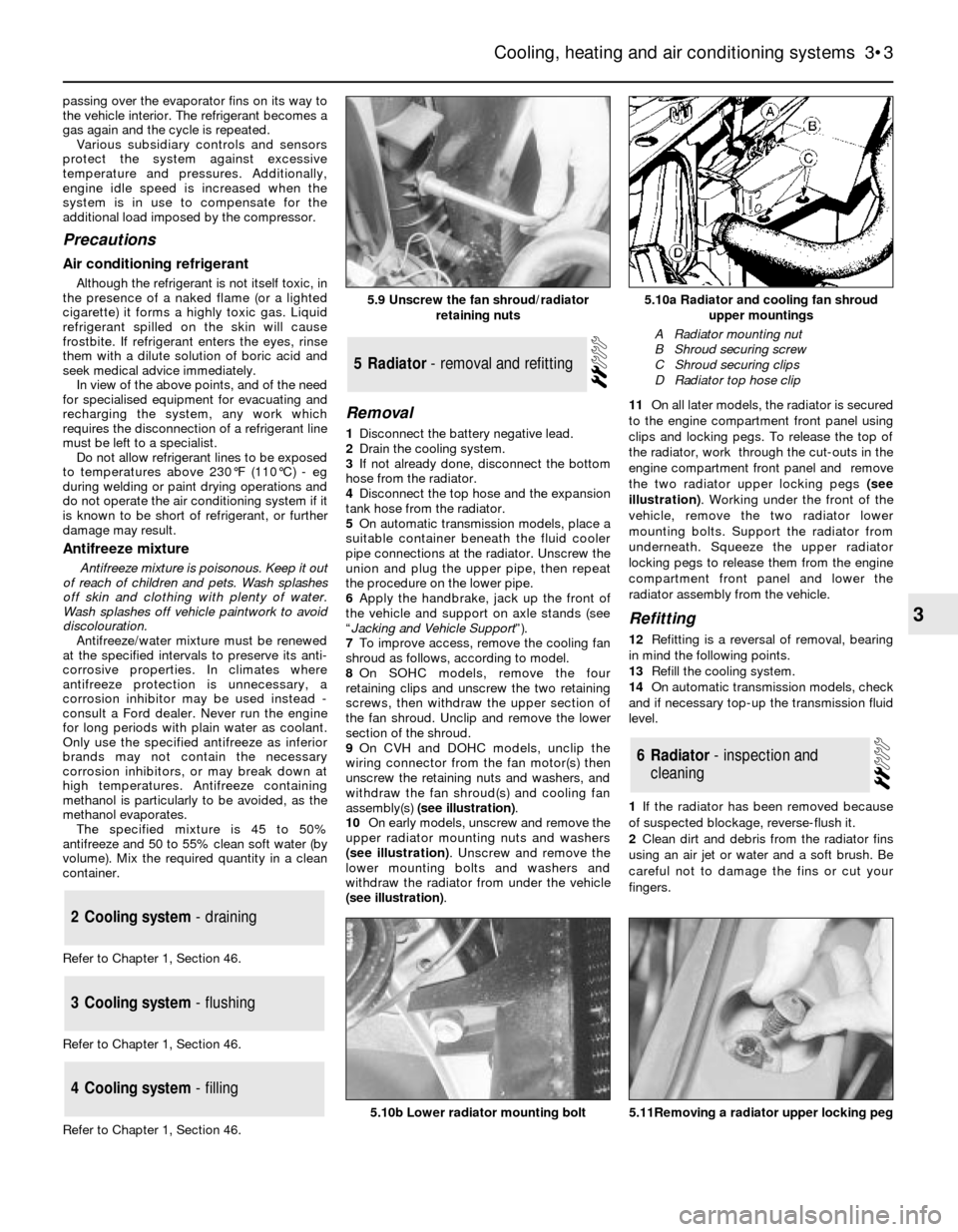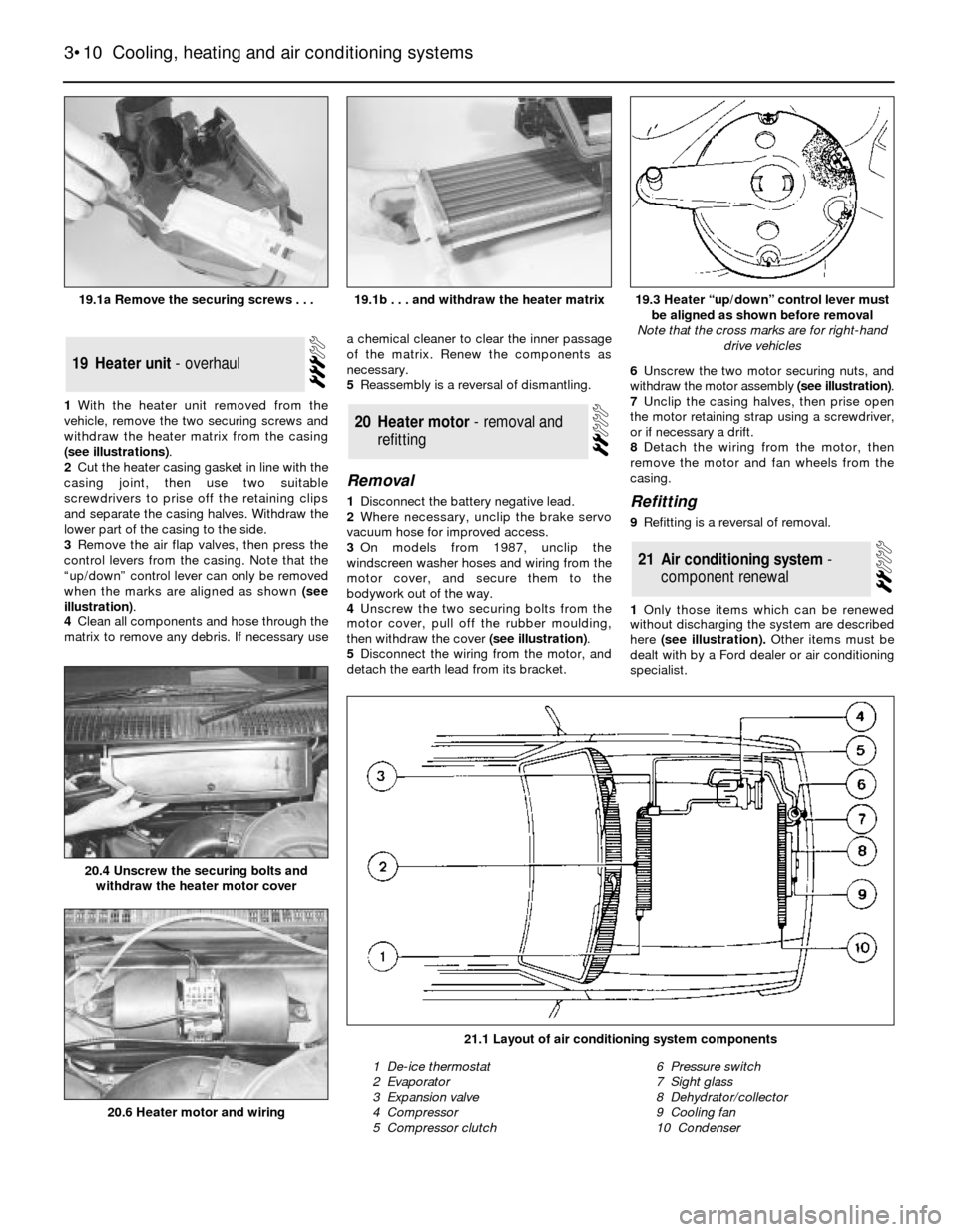charging FORD SIERRA 1992 2.G Cooling And Air Conditioning Systems Workshop Manual
[x] Cancel search | Manufacturer: FORD, Model Year: 1992, Model line: SIERRA, Model: FORD SIERRA 1992 2.GPages: 12, PDF Size: 0.62 MB
Page 3 of 12

passing over the evaporator fins on its way to
the vehicle interior. The refrigerant becomes a
gas again and the cycle is repeated.
Various subsidiary controls and sensors
protect the system against excessive
temperature and pressures. Additionally,
engine idle speed is increased when the
system is in use to compensate for the
additional load imposed by the compressor.
Precautions
Air conditioning refrigerant
Although the refrigerant is not itself toxic, in
the presence of a naked flame (or a lighted
cigarette) it forms a highly toxic gas. Liquid
refrigerant spilled on the skin will cause
frostbite. If refrigerant enters the eyes, rinse
them with a dilute solution of boric acid and
seek medical advice immediately.
In view of the above points, and of the need
for specialised equipment for evacuating and
recharging the system, any work which
requires the disconnection of a refrigerant line
must be left to a specialist.
Do not allow refrigerant lines to be exposed
to temperatures above 230°F (110°C) - eg
during welding or paint drying operations and
do not operate the air conditioning system if it
is known to be short of refrigerant, or further
damage may result.
Antifreeze mixture
Antifreeze mixture is poisonous. Keep it out
of reach of children and pets. Wash splashes
off skin and clothing with plenty of water.
Wash splashes off vehicle paintwork to avoid
discolouration.
Antifreeze/water mixture must be renewed
at the specified intervals to preserve its anti-
corrosive properties. In climates where
antifreeze protection is unnecessary, a
corrosion inhibitor may be used instead -
consult a Ford dealer. Never run the engine
for long periods with plain water as coolant.
Only use the specified antifreeze as inferior
brands may not contain the necessary
corrosion inhibitors, or may break down at
high temperatures. Antifreeze containing
methanol is particularly to be avoided, as the
methanol evaporates.
The specified mixture is 45 to 50%
antifreeze and 50 to 55% clean soft water (by
volume). Mix the required quantity in a clean
container.
Refer to Chapter 1, Section 46.
Refer to Chapter 1, Section 46.
Refer to Chapter 1, Section 46.
Removal
1Disconnect the battery negative lead.
2Drain the cooling system.
3If not already done, disconnect the bottom
hose from the radiator.
4Disconnect the top hose and the expansion
tank hose from the radiator.
5On automatic transmission models, place a
suitable container beneath the fluid cooler
pipe connections at the radiator. Unscrew the
union and plug the upper pipe, then repeat
the procedure on the lower pipe.
6Apply the handbrake, jack up the front of
the vehicle and support on axle stands (see
“Jacking and Vehicle Support”).
7To improve access, remove the cooling fan
shroud as follows, according to model.
8On SOHC models, remove the four
retaining clips and unscrew the two retaining
screws, then withdraw the upper section of
the fan shroud. Unclip and remove the lower
section of the shroud.
9On CVH and DOHC models, unclip the
wiring connector from the fan motor(s) then
unscrew the retaining nuts and washers, and
withdraw the fan shroud(s) and cooling fan
assembly(s) (see illustration).
10On early models, unscrew and remove the
upper radiator mounting nuts and washers
(see illustration). Unscrew and remove the
lower mounting bolts and washers and
withdraw the radiator from under the vehicle
(see illustration).11On all later models, the radiator is secured
to the engine compartment front panel using
clips and locking pegs. To release the top of
the radiator, work through the cut-outs in the
engine compartment front panel and remove
the two radiator upper locking pegs (see
illustration). Working under the front of the
vehicle, remove the two radiator lower
mounting bolts. Support the radiator from
underneath. Squeeze the upper radiator
locking pegs to release them from the engine
compartment front panel and lower the
radiator assembly from the vehicle.
Refitting
12Refitting is a reversal of removal, bearing
in mind the following points.
13Refill the cooling system.
14On automatic transmission models, check
and if necessary top-up the transmission fluid
level.
1If the radiator has been removed because
of suspected blockage, reverse-flush it.
2Clean dirt and debris from the radiator fins
using an air jet or water and a soft brush. Be
careful not to damage the fins or cut your
fingers.
6Radiator -inspectionand
cleaning
5Radiator - removal and refitting
4Cooling system - filling
3Cooling system - flushing
2Cooling system - draining
Cooling, heating and air conditioning systems 3•3
3
5.10a Radiator and cooling fan shroud
upper mountings
A Radiator mounting nut
B Shroud securing screw
C Shroud securing clips
D Radiator top hose clip
5.11Removing a radiator upper locking peg5.10b Lower radiator mounting bolt
5.9 Unscrew the fan shroud/radiator
retaining nuts
Page 10 of 12

1With the heater unit removed from the
vehicle, remove the two securing screws and
withdraw the heater matrix from the casing
(see illustrations).
2Cut the heater casing gasket in line with the
casing joint, then use two suitable
screwdrivers to prise off the retaining clips
and separate the casing halves. Withdraw the
lower part of the casing to the side.
3Remove the air flap valves, then press the
control levers from the casing. Note that the
“up/down” control lever can only be removed
when the marks are aligned as shown (see
illustration).
4Clean all components and hose through the
matrix to remove any debris. If necessary usea chemical cleaner to clear the inner passage
of the matrix. Renew the components as
necessary.
5Reassembly is a reversal of dismantling.
Removal
1Disconnect the battery negative lead.
2Where necessary, unclip the brake servo
vacuum hose for improved access.
3On models from 1987, unclip the
windscreen washer hoses and wiring from the
motor cover, and secure them to the
bodywork out of the way.
4Unscrew the two securing bolts from the
motor cover, pull off the rubber moulding,
then withdraw the cover (see illustration).
5Disconnect the wiring from the motor, and
detach the earth lead from its bracket. 6Unscrew the two motor securing nuts, and
withdraw the motor assembly (see illustration).
7Unclip the casing halves, then prise open
the motor retaining strap using a screwdriver,
or if necessary a drift.
8Detach the wiring from the motor, then
remove the motor and fan wheels from the
casing. Refitting
9Refitting is a reversal of removal.
1Only those items which can be renewed
without discharging the system are described
here(see illustration).Other items must be
dealt with by a Ford dealer or air conditioning
specialist.
21Air conditioning system -
component renewal
20Heater motor - removal and
refitting
19Heater unit - overhaul
3•10Cooling, heating and air conditioning systems
19.1a Remove the securing screws . . .19.3 Heater “up/down” control lever must
be aligned as shown before removal
Note that the cross marks are for right-hand
drive vehicles
1 De-ice thermostat
2 Evaporator
3 Expansion valve
4 Compressor
5 Compressor clutch6 Pressure switch
7 Sight glass
8 Dehydrator/collector
9 Cooling fan
10 Condenser
21.1 Layout of air conditioning system components
20.6 Heater motor and wiring
20.4 Unscrew the securing bolts and
withdraw the heater motor cover
19.1b . . . and withdraw the heater matrix